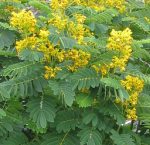
American senna is a herbaceous perennial native to eastern US from Michigan and Maine through the Appalachians and Atlantic plains south to Georgia where it grows in moist open woodlands, meadows, pastures, fields or roadsides. It is a member of the pea family, Fabaceae, that also includes lupine, mimosa, and black locust. Plants grow up to 6′ tall from root system consisting of tap root and rhizomes and have a sparsely branched stout stem that is light green and slightly hairy in its upper areas. The compound leaves have 5-10 pairs of oblong gray-green to medium green leaflets up to 2.5″ long. In mid to late summer yellow flowers 3/4″ across appear in both terminal and axial heads or spikes up to 1′ long. Unlike many other legumes, the flowers of American senna are not pea-like and lack nectaries although nectaries are present at the base of leaf petioles. The flat dry fruit is 3-4″ long, dark brown, and has 10-18 segments each filled by a single seed. The flowers are attractive to and are good for the vase. Plants are an excellent addition to meadow, wildflower, wildlife, or native plant gardens. They grow best with plenty of moisture but tolerate drought well once established. The genus name, Senna, is the Arabic word sena describing plants that have leaves and pods with cathartic and laxative properties. The specific epithet, hebecarpa, may be the Greek word meaning youth, and the Greek suffix meaning fruited.
Type:Herbaceous perennial
Bloom: Heads or spikes of small yellow flowers from mid to late summer
Size: 3-6′ H x 2.5-3′ W
Light:Full sun to partial shade
Soil:Average, medium moist, well-drained but tolerates less
Hardiness: Zones 4-7
Care:Stake if floppy
Pests and Diseases: None of significance
Propagation: Seed
Companion Plants: Tall coneflower, tall larkspur, prairie aster, black eyed susan (R. hirta), joe pye weed